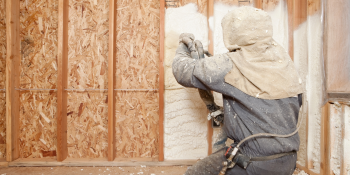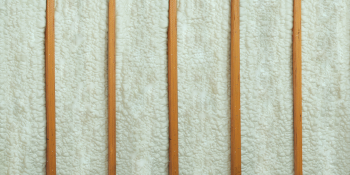Q&A Forums
vapor barrier? Post New Topic | Post Reply
| Author | Comments |
|---|---|
|
Craig Maturi
Posted: Apr 15, 2007 10:54 AM
|
vapor barrier?
i am doing a bid for open cell and the guy wants an R-50 on the underside of his roof deck. i live in Minnesota, does anyone know if i'm gonna hafta install a vapor barrier up there????? also what does everyone suggest about shute vents from soffit to peak, yes or no?????
|
|
Thomas Kasper
Posted: Apr 15, 2007 11:27 AM
|
Yes, the underside of a roof needs a vapor barrier In the northern climates. It is possible the moisture in the home will rise and when it gets to the foam it will pass through the open cell foam and get to the roof deck and be trapped, and eventually rot the roof deck. Or, in the foam itself the air is cooled down to the dew point and is turned to a liquid. Either way moisture gets to the roof deck and stays there. This is one thing that has been a problem for foamers. If one roof deck rots out, it causes bad word of mouth for decades. I know of a couple roof decks that have rotted a few years after open cell foam was installed. Some of the problems depend on the house. A house with in floor heat and a air exchanger will not be as much of a problem as a house with a cold concrete floor and without a air exchanger. Spray open cell foam to the roof deck and install a vapor barrier. |
|
Gerry Wagoner
Posted: Apr 15, 2007 09:19 PM
|
There is a program called WUFI which can model the project. I don't believe a vapor barrier will be necessary at 13.5" of foam (in most cases). Foam dries out quicker than it gets wet. If the source is vapor transfusion, and the source is constant (like a deep freeze) than the foam would never dry out. This is rare. A standard home in which the interior humidity is 40-50% should have no problem. I question the rotting roof deck scenario in 98% of the homes in our North American climate. good luck and have fun, oG |
|
Jason Kron
Posted: Apr 18, 2007 07:33 PM
|
I agre with Olger. Is open cell required? One thought might be to go with a closed cell foam, because you will get a lower perm rating. Now it is more lifts and work but the extra skins in between may help with your perm rating. Also if it is in MN you may want to check with building officals, I have worked their Department of Commerce, State Energy Office and they may be able to shine some light of the situation. Good luck |
|
Jason Kron
Posted: Apr 18, 2007 07:33 PM
|
I agre with Olger. Is open cell required? One thought might be to go with a closed cell foam, because you will get a lower perm rating. Now it is more lifts and work but the extra skins in between may help with your perm rating. Also if it is in MN you may want to check with building officals, I have worked their Department of Commerce, State Energy Office and they may be able to shine some light of the situation. Good luck |
|
Posted: Apr 21, 2007 10:10 PM
|
Minnesota is a little different than other states around it... Minnesota will allow you to do an hot roof (spraying to the underside of the roof) But at this time the Main Inspectors are asking that chute vents be placed in every cavaity going to the peak of the roof.. If you met those requirements and you get the approval of the local city inspector , they should sign off of the Hot Roof Project.. Now for open cell... the dew point at 5.5" in the middle of the foam and it will never touch the plywood on the roof deck.. Open Cell foam is an Air Barrier and will not allow air (or moisture into the foam- it stops the air movement. But Open Cell breathes... and if water or moisture were to get into the foam - open cell will dry itself out.. Here is the Reason Why Closed cell is BAD for an attic assembly... It is an Air Barrier and Water Barrier - if you had a leak in the roof - you will never know it until you stepped through the roof.... Open Cell you will know that you have a leak in the roof and you better fix it soon.. |
|
Posted: Apr 22, 2007 12:06 PM
|
I think if you have a leak you have a leak, it doesn't matter which foam you have. To say that closed cell is bad because it masks the leak is a bit of a stretch. The benefits of closed cell outweigh the "leak problem". With proper vents and fiberglass, the "leak" may travel quite a distance from its origination before it becomes visible. So you may not find that leak until you put your foot through or tear out half the insulation to find it. My point is, just because there is a potential for a problem should not limit you from using the best products for the job. Tim Granite State Spray Foam Co. |
|
Thomas Kasper
Posted: Apr 22, 2007 01:37 PM
|
Oakridge, The experience I have with spraying foam to the chutes causes the chutes to collapse. Closed cell anyway. I don't know about open cell I never tried it. Maybee I don't know the right spray technique. What are people doing? Am i the only one that the chutes collapse on? |
|
Posted: Apr 22, 2007 02:25 PM
|
Tom, If you spray a really light flash coat/skim coat whatever, I have found that the proper vents will retain their shape and not collapse. It is a pain and waste of time, but it can be done with closed cell as well. Tim Granite State Spray Foam Co. |
|
Thomas Kasper
Posted: Apr 22, 2007 03:25 PM
|
Tim, I didn't know that. I guess you would have to be carefull, because if you collapsed a chute in one spot it would void the whole cavity. Out east are you using the plastic chutes? I just started seeing them last fall. They seem alot tougher then the foam ones we had for years. |
|
SprayFoamSupply.com
Posted: Apr 22, 2007 07:50 PM
|
Open cell foam is not a moisture barrier. It doesn't allow the movement of moisture laden air through it, buy will allow water vapor to be forced through it if conditions are right, when it extremely cold outside. With closed cell foam, even if the plywood deck rotted away, you would not be able to step through the roof, the foam would easily support your weight. George |
|
Posted: Apr 22, 2007 11:14 PM
|
"Here is the Reason Why Closed cell is BAD for an attic assembly... It is an Air Barrier and Water Barrier - if you had a leak in the roof - you will never know it until you stepped through the roof." cripes... you gotta be a salesman.... |
|
Luke Kujacznski
Posted: Apr 23, 2007 08:32 AM
|
Now for open cell... the dew point at 5.5" in the middle of the foam and it will never touch the plywood on the roof deck.. Open Cell foam is an Air Barrier and will not allow air (or moisture into the foam- it stops the air movement. But Open Cell breathes... and if water or moisture were to get into the foam - open cell will dry itself out. I would like to see the air barrier info on your open cell foam, if it breathes how is it an air barrier? If open cell is so good on the underside of roof decks and so good at drying out why does the largest open cell dealer in the country have hundreds of lawsuits on their desk for "foam saturation" and mold problems. Did they do you trying because you don't have all your facts right. |
|
Gerry Wagoner
Posted: Apr 25, 2007 09:27 PM
|
"I think if you have a leak you have a leak, it doesn't matter which foam you have. To say that closed cell is bad because it masks the leak is a bit of a stretch." Hearty agreement with Sir Tim from olger. Closed cell is a superior product in spite of the desires of some to denigrate it. Both foams have their place, but open cell is almost NEVER superior to closed cell. yup, olger |





























